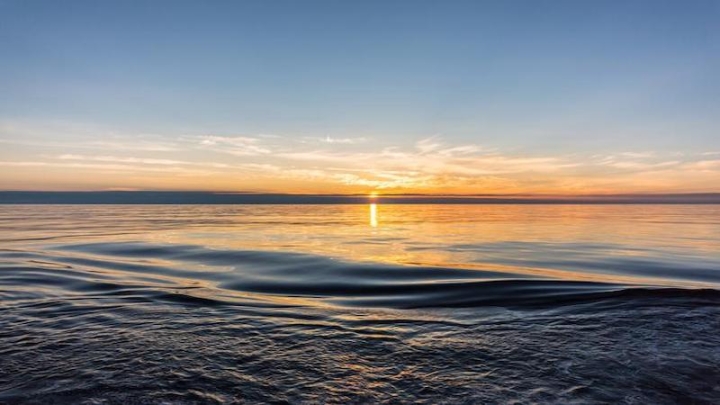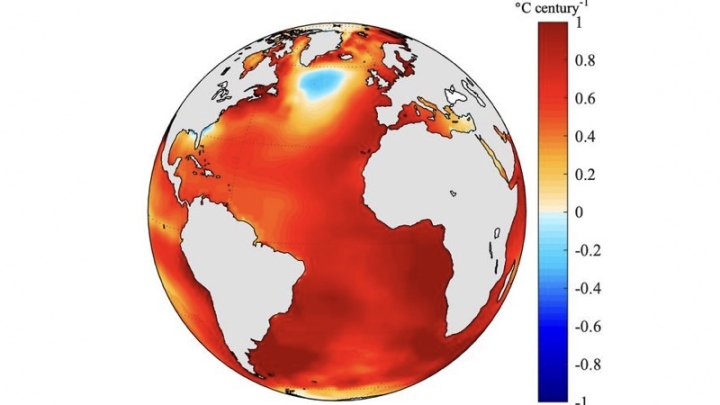
In the last few decades, the Arctic sea ice has receded ever further, including increasingly in winter when the extent of sea ice is at its most prominent. One of the main drivers of this development is thought to be the warming of Atlantic water that flows from Europe’s Norwegian Sea into the Arctic Ocean, passing through the Barents Sea and the Fram Strait in the process.
However, not all the Atlantic water flowing into the Barents Sea reaches the sea ice. Part of the Atlantic water recirculates, i.e. by changing direction and flowing back into Europe’s Norwegian Sea as an independent current without coming into direct contact with the sea ice. To date, however, it has not been possible to sufficiently investigate the indirect effect of this current carrying inflowing Atlantic water back out of the Barents Sea on the sea ice of the Barents Sea. A research team from the Alfred Wegener Institute has now discovered — using model simulations — that this return flow from the Barents Sea has an appreciable impact on the amount of sea ice forming in the Barents Sea in winter. The researchers published their results in the journal Nature Communications.
Besides the Fram Strait, the Barents Sea is one of two gateways through which warm, saline water from the Atlantic flows into the Arctic Ocean. If the inflowing Atlantic water is warmer than the long-term average or if an extraordinarily large volume of Atlantic water flows in, the Barents Sea warms up and the ice coverage in winter is lower. If the Atlantic water is cooler or the inflow is weak, a great deal of ice may result. However, before the Atlantic water is transported to the sea ice by the currents in the Barents Sea, part of it recirculates away from the sea ice and is carried back into Europe’s Norwegian Sea. Consequently, this recirculated portion can no longer affect the sea ice. To date, however, it has not been possible to adequately measure the strength and fluctuations of this return flow although these factors might play a vital part in determining how much Atlantic water actually reaches the sea ice.
“There are a few observations that strongly suggest that this return flow carries a substantial proportion of the Atlantic water directly back out of the Barents Sea. Therefore, it seemed to make sense that naturally occurring fluctuations and any possible long-term trend in this current could be important factors for the sea ice”, says Dr. Finn Heukamp, lead author of the study by the Alfred Wegener Institute, Helmholtz Centre for Polar and Marine Research. “The volume of Atlantic water flowing into the Barents Sea, while leaving it again immediately as a result of recirculation may have a substantial effect on the formation of sea ice from year to year but also over the long term.
The return flow from the Barents Sea has not been as well documented to date as the inflow, the strength and fluctuations of which are known as a result of long-term measurements. “In such cases, computer models that map the ocean represent an excellent initial source of information that allow us to investigate what is happening. We have therefore simulated the return flow of warm Atlantic water between 1979 and 2019 by way of a high-resolution, global ocean and sea ice model”, Finn Heukamp explains. What the AWI oceanographer and his fellow researchers discovered was that the volume of Atlantic water flowing back out of the Barents Sea actually affects how much sea ice can form. “If the return flow is weaker, less Atlantic water is immediately transported out again. Instead of leaving the Barents Sea, this Atlantic water flows through it and warms it up. The consequence is that less new sea ice is formed in such years and existing ice melts faster.” By contrast, a strong return flow leads to more ice in the Barents Sea, he explains, as a large volume of the warm Atlantic water is immediately carried out of the Barents Sea before it can reach and affect the sea ice.
More and more warm Atlantic water able to reach the sea ice
Consequently, it is not only important to determine the volume of warm Atlantic water flowing into the Barents Sea but also how much of it immediately leaves it again. This is the precise volume that has been steadily shrinking since 1979. For example, the simulation shows that although the volume of Atlantic water flowing out again varies sharply from year to year, overall the return flow is weakening noticeably as a result of which more warm water is reaching the sea ice. In the simulation, the return flow has already roughly halved since 1979. This development contributes to the accelerated loss of sea ice in the Barents Sea.
While the volume of warm Atlantic water flowing out of the Barents Sea in winter has decreased over time, there is no discernible trend in the inflow. However, the temperature fluctuations and general warming of the inflow are also reflected in the return flow. “In the model, the inflow in the winter is consistently warmer and more stable than the return flow which is somewhat cooler but much more variable.” The fact that the temperatures of both currents appear to be connected although the volumes of inflowing and outflowing water but not the volume of the inflowing and return flowing water, points to a permanent return flow, as well as to independent (atmospheric) driving mechanisms in the Barents Sea which control the inflow and return flow. For example, the strength of the inflow of Atlantic water is largely tied to the large-scale wind pattern of the North Atlantic Oscillation, while the return flow seems to depend heavily on local weather systems over Spitzbergen.
“Our study can serve as the starting point for identifying the very processes which are pivotal in driving the return flow in the Barents Sea”, Finn Heukamp states in summary. “For the first time, we are shedding light on a previously disregarded mechanism in the oceanic Arctic system which directly impacts the extent of the sea ice.” This is hugely relevant to climate models and lends important momentum to more precise projections of the development of Arctic climate change in the future.

